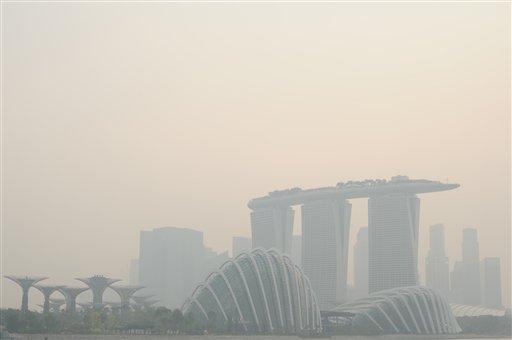Air pollution in Singapore soared to record heights for a third consecutive day, as Indonesia dispatched planes and helicopters Friday to battle raging fires blamed for hazardous levels of smoky haze in three countries.
The blazes in peat swamp forests on Indonesia’s Sumatra island have sent massive plumes of smog across the sea to neighboring Singapore and Malaysia, both of which have grown impatient with Indonesia’s response to the perennial problem.
Singapore is suffering its worst haze in history. Its main air pollution index hit a measurement of 401 at midday Friday June 21, 2013, exceeding previous highs of 371 on Thursday and 321 on Wednesday, both of which were record readings. Those measurements were classified as “hazardous” and can aggravate respiratory ailments, but even readings above 101 are considered unhealthy.
“The … level keeps changing, most of the time it is at the very unhealthy, hazardous level. This afternoon [June 22, 2013], for the first time we got some relief,” said Celine Bonassieux, a foreign national working in Singapore. After five days, she “managed to air the flat a bit and do some grocery shopping.”
She also said that supplies of protective face masks have run out and reports that profiteers are taking advantage of the situation. “Yesterday none of my friends could buy N95 masks, all were sold out … Some people bought to sell them on the internet at a much higher price; four times the regular price. Some asked 10 Singapore dollars ($7.8) for a mask worth two ($1.6).”
She was “sad and extremely disappointed that, in a moment of such crisis, so many seek quick material gain, lacking basic concern for the vulnerable ones in their community … ”
Mrs. Bonassieux herself was suffering from irritation in the eyes, her throat and respiratory tracks. “Slowly but surely our health is being affected,” she said. She commented on the way buildings in Singapore are designed to keep the apartments cool in the tropical country. This design, which does not feature isolated windows, is letting smoke fill whole apartment blocks and offices.
“When it reaches the 300 level, everything at home stinks. It gets into your house under the door and through the windows.”
To alleviate the citizens’ concerns Singapore’s environment minister, Vivian Balakrishnan, flew to Jakarta on Friday to discuss measures to tackle the forest fires that break out in Indonesia during midyear dry spells because of carelessly discarded cigarettes and illegal blazes set by plantations and farmers to clear land.
“People, to be honest with you, are angry,” Balakrishnan told reporters in Indonesia. “People want to see action on the ground.”
Sutopo Purwo Nugroho, an official in Indonesia’s National Disaster Management Agency, said 10 aircraft were sent to Sumatra on Friday to help extinguish the fires. Three helicopters will lead a “water-bombing” effort to assist more than 100 firefighters on the ground, while planes will conduct “cloud-seeding” to try to chemically induce rain.
The dirty, acrid haze has slashed visibility and shrouded many of Singapore’s towering landmarks, forcing airports to take extra precautions, the military to reduce outdoor training and some fast food businesses to suspend delivery services. Elderly residents, children and pregnant women have been advised to avoid all outdoor activity.
Celine Bonassieux however, thinks that the government has misinformed other citizens on at least one occasion with respect to the air pollution readings. “On Friday morning when it was time for everyone to go to the office, everyone checked the index reading on the official website. It [said it was] a bit more than 100, which was impossible because I could not see the building that I get to see when index is near 300. So it looked like we are being misinformed just not to panic and go to the office.”
Other people are working as usual says Mrs. Bonassieux who has seen construction work continue, even at hazardous levels.
In Indonesia, some airports in Sumatra have closed because of poor visibility and pollution levels that exceeded Singapore’s.
In neighboring Malaysia, officials shut nearly 600 schools Friday in southern districts near Singapore. Most of Malaysia, including the main city, Kuala Lumpur, was not as badly affected, though two southernmost towns recorded hazardous air quality.
Celine Bonassieux was very concerned about the people in Malaysia as well, as they lack the high-level infrastructure that Singapore has. She also called out for “international help to put out these fires.” “Apart from us here, tons of people in Malaysia suffer and I am sure they lack the air conditioning we have here for our relief, not to mention some in Indonesia.”
The Associated Press contributed to this report.






Friends Read Free